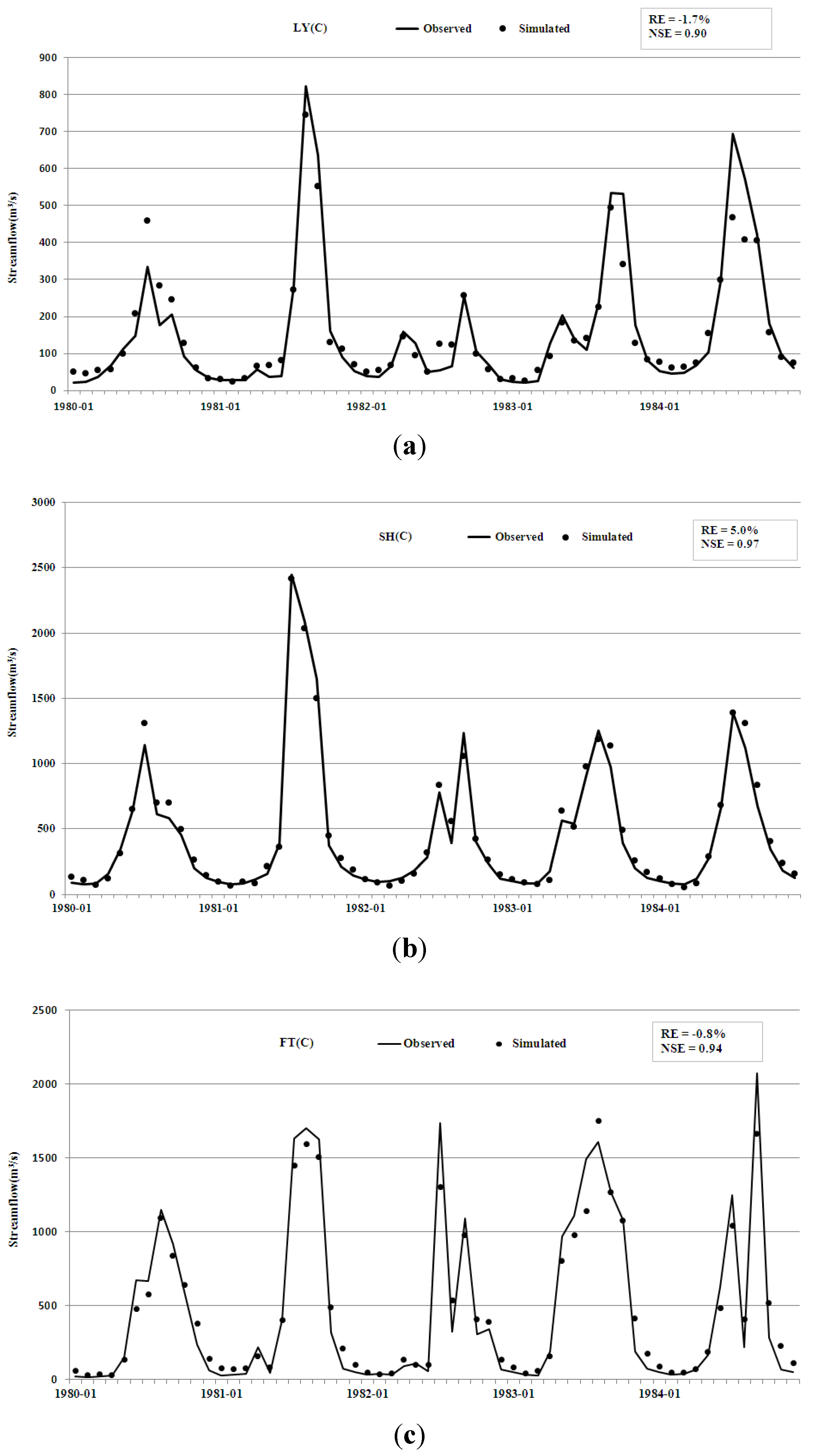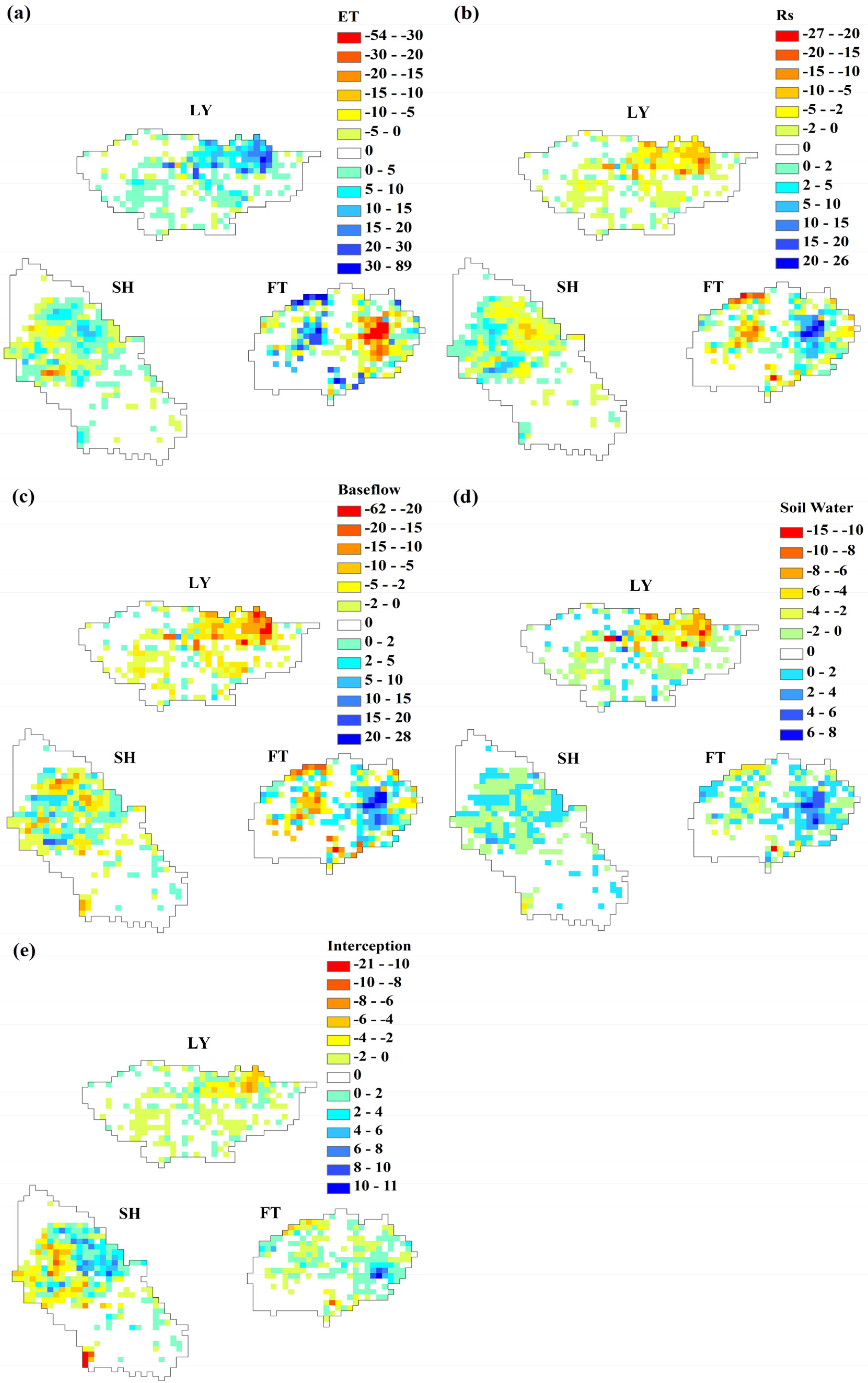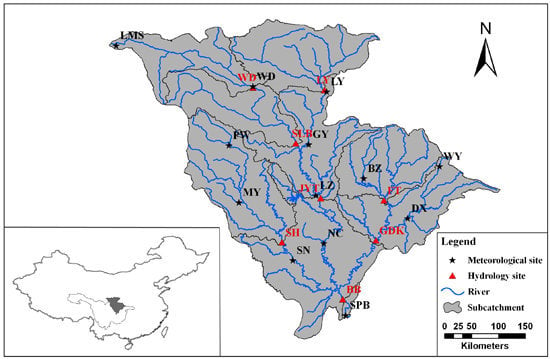4.1. Land Use Change
To reflect the dynamic character of spatial land use changes during a specific period, an in-and-out phenomenon is described in
Section 3.1. If only the final change is used in the analysis, the real change will be hidden in the process of land use change. For example, this study found that the woodland area in the Jialing River Basin was 31,670 km
2 in the 1980s (land use 1985) and 32,193 km
2 in the 1990s (land use 1995), which resulted in a final change of 523 km
2 (
Table 2). From 1985 to 1995, 3894 km
2 of woodlands were converted into other land use types, and 3371 km
2 of other types of land use were converted to woodland (
Table 3). Therefore, the actual change related to woodlands (real change) was up to 7265 km
2. In this paper, both the change rate and the change in the area of woodlands were highlighted. This in-and-out phenomenon directly affected the detectability of changes in the hydrological regimes that were caused by land use changes, because the changes in the hydrological elements were normally expressed as an overall value for a catchment or a statistical unit in which the in-and-out phenomenon existed.
From the analysis in
Section 3.1, it is clear that the land use along the Jialing River significantly changed. The forces driving the frequent transfer and conversion primarily included economic, population and macro-policy forces. In pursuit of economic development, humans have engaged in extensive land use changes, including building and grazing. These changes have resulted in reduced croplands and the degradation of grasslands, which have resulted in environmental deterioration, but also in changes in land use type. In addition, farmers have adjusted the structure of agricultural production to increase their income, and more young people in rural areas have sought better jobs in large cities. All of these factors have indirectly affected land use patterns. Since 1980, the rapid economic development of the Jialing River has accelerated the urbanization process, which has resulted in the conversion of cropland to other types of land use and has resulted in a greater amount of land under construction. Population is an important factor that could lead to land use change. A population increase results in greater residential land. From the 1980s to 2000, the area of settlement in the Jialing River Basin increased steadily from 313 km² in the 1980s to 378 km² in 1995 and to 489 km² in 2000. However, additional croplands are required to feed the growing population. Since 1985, due to the continuing population growth in the Jialing River Basin (43.9 million in 1995, 44.8 million in 2000, calculated from 1 km × 1 km grid datasets of population, China), industrial development and the expansion of farming areas inevitably resulted in decreasing woodland and grassland areas. Population pressure and human activities are the main reasons for the dramatic changes in the woodland area. In addition, macro-policy is a factor that cannot be neglected. In the 1980s, the government of the P.R. of China implemented a policy to construct a huge shelter-forest system upstream of the Yangtze River. This project was called the “Yangtze River Management” project. The affected area was approximately 200,000 km
2, covering Sichuang, Yunnan, Guizhou and Hubei provinces, and included the Tuo River, Min River, Jialing River, Wu River and the mainstream of the Three Gorges [
48]. Since the 1990s, a national policy of returning cropland to woodlands and grasslands (RCFG) has been implemented. Furthermore, maintaining a dynamic balance of arable land is currently a basic land use policy in China. All of these factors contributed to dynamic changes in land use within the Jialing River Watershed.
4.2. Hydrological Response
In LY, woodlands increased by 944 km
2 (croplands, shrublands and grasslands decreased by 193 km
2, 452 km
2 and 303 km
2, respectively) from 1985 to 1995. In addition, from 1995 to 2000, 936 km
2 of woodlands were converted into croplands, shrublands and grasslands, which increased by 216 km
2, 453 km
2 and 267 km
2, respectively. As the woodland area increased, the ET decreased (S1-S0) and
vice versa (
Table 9). In terms of the hydrological effects of the woodlands, many researchers [
3,
4,
7] have concluded that harvesting forests or converting them into grasslands or croplands decreases the ET because the canopy interception decreases. However, we observed an increase in the ET in this study. Actually, the effects of land use change on hydrological processes are extremely complex. In addition to the biophysical characteristics of vegetation, such as LAI, albedo, stoma resistance and root distribution, differences in the background climate are also important. Actual ET is similar to potential ET for the humid climate characteristic of the upstream region of the Yangtze River [
49]. In addition, the lower temperature, higher moisture and slower air exchange in woodlands will decrease ET [
48]. Therefore, a decrease in forestland and shrubland may not result in a decrease in ET. The research institute of the Yangtze River Basin’s planning office has observed the same results in their study of paired subcatchments [
49]. Furthermore, a study by Zheng
et al. [
50] of the Pingtong River, one of the subcatchments in the Jialing River, has supported this conclusion.
In Scenarios S1-S0 and S2-S1, the hydrological regimes did not change noticeably, as we previously mentioned. However, the land use changed extensively. Lahmer
et al. [
51] applied a GIS-based modeling approach to two river basins and concluded that moderate land use change results in only small changes in various water balance components. Lu Zhixiang
et al. [
52] also did not detect obvious changes in hydrological elements, even in two of their three studied subcatchments, where land use changed significantly. Take Subcatchment 7 in their study, for example: from 1995 to 2000, the area of cropland decreased 26.94%, while woodland and grassland area increased 8.69% and 18.55%. Land use changes during this period only led to a 0.47- and 1.64-mm increase in ET and water yield and a 2.37-mm decrease in soil water. Thus, the current paper attempts to explain why this change occurred by combining the concepts of real change and final change with the spatial distribution maps (
Figure 4 and
Figure 5) and statistic distribution tables of the hydrological elements (
Table 11,
Table 12,
Table 13,
Table 14 and
Table 15).
Table 11.
Statistic distribution of ET variation in Scenario S1-S0 (area percentage, %).
Table 11.
Statistic distribution of ET variation in Scenario S1-S0 (area percentage, %).
| ET | −89–−30 | −30–−20 | −20–−15 | −15–−10 | −10–−5 | −5–0 | 0 | 0–5 | 5–10 | 10–15 | 15–20 | 20–30 | 30–59 |
|---|
| LY | 0.2 | 1.6 | 1.8 | 3.7 | 6.5 | 22.6 | 54.3 | 8.9 | 0.2 | 0.2 | 0 | 0 | 0 |
| SH | 0 | 0.2 | 0.3 | 2.4 | 6.9 | 22.7 | 53.0 | 12.7 | 0.9 | 0.7 | 0.2 | 0 | 0 |
| FT | 2.2 | 2.5 | 2.2 | 4.2 | 4.7 | 10.6 | 44.2 | 12.3 | 6.1 | 4.9 | 2.0 | 2.2 | 2.0 |
Table 12.
Statistic distribution of Rs variation in Scenario S1-S0 (area percentage, %).
Table 12.
Statistic distribution of Rs variation in Scenario S1-S0 (area percentage, %).
| Rs | −27–−20 | −20–−15 | −15–−10 | −10–−5 | −5–−2 | −2–0 | 0 | 0–2 | 2–5 | 5–10 | 10–15 | 15–20 | 20–26 |
|---|
| LY | 0 | 0 | 0 | 0.2 | 0.4 | 9.1 | 54.5 | 21.3 | 8.1 | 4.5 | 1.4 | 0.4 | 0 |
| SH | 0 | 0 | 0.2 | 0.9 | 1.7 | 11.4 | 56.1 | 16.9 | 10.3 | 2.4 | 0.2 | 0 | 0 |
| FT | 0.5 | 1.5 | 1.0 | 4.4 | 7.6 | 12.0 | 45.5 | 11.1 | 7.6 | 5.2 | 1.5 | 0.5 | 1.7 |
Table 13.
Statistic distribution of baseflow variation in Scenario S1-S0 (area percentage, %).
Table 13.
Statistic distribution of baseflow variation in Scenario S1-S0 (area percentage, %).
| Baseflow | −31–−20 | −20–−15 | −15–−10 | −10–−5 | −5–−2 | −2–0 | 0 | 0–2 | 2–5 | 5–10 | 10–15 | 15–20 | 20–62 |
|---|
| LY | 0 | 0 | 0 | 0.2 | 1.0 | 8.1 | 54.5 | 18.7 | 10.4 | 5.9 | 1.2 | 0 | 0 |
| SH | 0 | 0 | 0.2 | 0.7 | 2.1 | 13.9 | 52.8 | 18.2 | 7.9 | 4.1 | 0 | 0 | 0 |
| FT | 1.2 | 1.5 | 2.0 | 7.9 | 10.8 | 6.4 | 44.5 | 5.2 | 8.1 | 7.1 | 2.7 | 2.0 | 0.7 |
Table 14.
Statistic distribution of soil water variation in Scenario S1-S0 (area percentage, %).
Table 14.
Statistic distribution of soil water variation in Scenario S1-S0 (area percentage, %).
| Soil water | −9–−8 | −8–−6 | −6–−4 | −4–−2 | −2–0 | 0 | 0–2 | 2–4 | 4–6 | 6–9 | 9–15 |
|---|
| LY | 0 | 0.2 | 0.2 | 0.8 | 8.1 | 54.5 | 19.5 | 6.5 | 5.7 | 3.9 | 0.6 |
| SH | 0 | 0 | 0 | 0.3 | 15.7 | 57.3 | 25.1 | 1.4 | 0.2 | 0 | 0 |
| FT | 0.2 | 0.2 | 2.2 | 5.7 | 21.1 | 44.5 | 17.4 | 6.4 | 2.0 | 0.0 | 0.2 |
Table 15.
Statistic distribution of interception variation in Scenario S1-S0 (area percentage, %).
Table 15.
Statistic distribution of interception variation in Scenario S1-S0 (area percentage, %).
| Interception | −12–−10 | −10–−8 | −8–−6 | −6–−4 | −4–−2 | −2–0 | 0 | 0–2 | 2–4 | 4–6 | 6–8 | 8–10 | 10–21 |
|---|
| LY | 0 | 0 | 0 | 0 | 0.2 | 14.2 | 55.9 | 24.0 | 3.0 | 2.2 | 0.4 | 0 | 0 |
| SH | 0.3 | 0.7 | 2.9 | 2.9 | 7.1 | 15.0 | 52.8 | 11.0 | 4.3 | 1.7 | 0.3 | 0.3 | 0.5 |
| FT | 0.2 | 0.2 | 0.5 | 0.7 | 2.5 | 28.7 | 47.2 | 18.9 | 0.7 | 0 | 0 | 0.2 | 0 |
Change in the hydrological elements in S1-S0 can be used as an example, because in this scenario, the hydrological element changed the most. In
Figure 4, we can see that the local hydrological elements changed significantly. ET changed from −89 to 59 mm. The generation of surface water changed from −27 to 26 mm. The baseflow changed from −31 to 62 mm, and the soil water and interception changed from −9 to 15 mm and from −12 to 21 mm, respectively. However, the magnitudes of change in the hydrological components in each subcatchment (LY, SH and FT) were not obvious (
Table 9). This finding may be explained by the compensation and average effects.
In LY, the difference between the final change and the real change in the hydrological elements was not great (
Table 9 and
Table 10), which indicated that compensation effect was not obvious. This outcome resulted from the unique directions of change in LY (
Figure 4 and
Table 11,
Table 12,
Table 13,
Table 14 and
Table 15). There were 36.4% of the grids with decreased ET values. Only in 9.3% of area did ET increase. However, other elements have the opposite variation characteristics. Rs, baseflow, soil water content and interception increased in 35.8%, 36.2%, 36.2% and 29.7% and decreased in 9.8%, 9.3%, 9.3% and 14.4% of the area, separately. Thus, the compensation effect of each element was small. Meanwhile, because many grids exhibited no change (around 54.5% of grids) or small change (ET: 22.6% of grids with a range of [−5–0); Rs: 29.4% of grids with a range of (0–5]; baseflow: 29.1% of grids with a range of (0–5]; soil water content: 31.7% of grids with a range of (0–6]; and interception: 29.3% of grids with a range of (0–6]), the average effect was great. Essentially, little overall change occurred in the hydrological regimes in LY.
SH and FT had more significant real changes than LY. In the SH and FT, positive and negative changes occurred in each element (
Figure 4 and
Table 11,
Table 12,
Table 13,
Table 14 and
Table 15). The compensation effect played an important role that made it difficult to detect the change. The FT showed the largest difference between real change and final change (
Table 9 and
Table 10). In FT, there was 26.3% of the area with decreased ET and 29.5% with increased ET. The proportions of area for other hydrological components (Rs, baseflow, soil water content and interception) with decreased values were 27.0%, 29.7%, 29.5% and 32.9%, separately. Correspondingly, the area percentages with increased values were 29.5%, 27.5%, 25.8%, 26.0% and 19.9%. The increased area and decreased area were similar. This made it difficult to detect variations that result from land use changes in the hydrological elements.
To detect obvious changes in hydrological components caused by land use change, it is necessary to pay attention to the scale problem. In a large watershed, the compensation and average effects may decrease the detectability.











